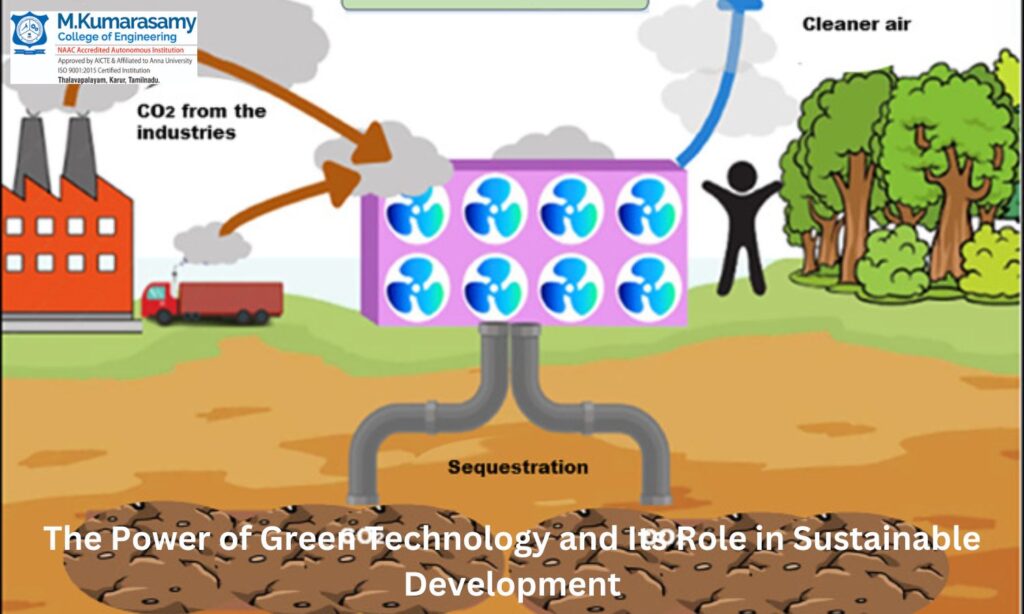The power of green technology resonates as a transformative force in today’s relentless pursuit of sustainable development. This pivotal innovation holds the promise of reshaping industries, conserving resources, and reducing humanity’s ecological footprint. For M.Kumarasamy College of Engineering (MKCE), the inclusion of green technology in its curriculum demonstrates its commitment to producing engineers equipped to tackle environmental challenges. Clearly, the power of green technology is not merely a buzzword but a necessity for achieving global sustainability goals.
Power of Green Technology
Redefining Energy Consumption
Green technology redefines energy consumption patterns by prioritizing renewable energy sources. Unlike conventional fossil fuels, solar, wind, and hydroelectric power minimize carbon emissions while ensuring energy efficiency. For instance, advanced photovoltaic cells and vertical wind turbines exemplify the power of green technology in providing clean energy solutions. Governments and industries worldwide increasingly adopt these technologies to mitigate climate change, which remains a pressing issue demanding immediate action.
Moreover, transitioning to renewable energy significantly reduces dependency on finite resources. This shift underscores the power of green technology as a cornerstone in building resilient energy systems. Furthermore, innovations like smart grids, which optimize energy distribution, reflect how green technology can seamlessly integrate into existing infrastructures, making sustainability not only achievable but practical on a global scale.
Revolutionizing Waste Management
Another critical domain where the power of green technology significantly contributes to sustainable development is waste management. Traditional waste disposal methods, such as landfilling and incineration, exacerbate pollution and squander valuable materials. In stark contrast, green technologies like advanced recycling systems, anaerobic digesters, and waste-to-energy plants offer efficient and eco-friendly alternatives.
These innovations not only reduce the volume of waste but also convert it into useful resources. For example, waste-to-energy plants generate electricity from biodegradable materials, thereby showcasing the dual benefits of waste reduction and energy production. Additionally, the adoption of circular economy models, driven by the power of green technology, transforms waste into a resource, reducing environmental harm and promoting economic sustainability.
Driving Sustainable Urbanization
Urbanization poses significant challenges to sustainability. However, the power of green technology enables cities to grow without compromising the environment. Smart city initiatives incorporate green technologies such as energy-efficient buildings, intelligent transportation systems, and green roofs. Consequently, these advancements reduce urban heat islands, lower greenhouse gas emissions, and improve overall livability.
For example, smart lighting systems powered by renewable energy illuminate streets only when needed, thereby conserving electricity and reducing operational costs. Similarly, electric and hybrid vehicles supported by extensive charging infrastructure exemplify the power of green technology in revolutionizing urban transportation. These innovations align with global efforts to combat urban pollution while fostering sustainable communities.
Power of Green Technology Enhancing Agricultural Practices
Agriculture, the backbone of human civilization, benefits immensely from the power of green technology. Precision agriculture, a groundbreaking innovation, leverages sensors, drones, and data analytics to optimize resource usage. By delivering water, fertilizers, and pesticides with pinpoint accuracy, farmers can maximize yields while minimizing environmental impact.
Furthermore, vertical farming and hydroponics illustrate the power of green technology in addressing land and water scarcity. These techniques enable year-round cultivation in controlled environments, ensuring food security for growing populations. Additionally, bioengineered crops resistant to pests and climate extremes further exemplify the role of green technology in fostering agricultural resilience. As a result, the agricultural sector is witnessing a paradigm shift toward sustainability and efficiency.
Combatting Climate Change with the Power of Green Technology

Climate change stands as the most daunting challenge of our era, and the power of green technology is pivotal in combating its effects. Carbon capture and storage (CCS) technologies, for instance, capture carbon dioxide emissions from industrial processes and store them underground. This innovation effectively reduces atmospheric carbon levels, mitigating global warming.
Additionally, green technology promotes afforestation through drones that plant trees over vast areas within minutes. These reforestation initiatives restore ecosystems and enhance biodiversity, further showcasing the power of green technology in reversing environmental degradation. Moreover, the development of biofuels and green hydrogen provides sustainable alternatives to fossil fuels, thereby reinforcing the fight against climate change. With such initiatives, the transition to a low-carbon future becomes increasingly attainable.
Educating Future Innovators
The integration of green technology education at MKCE emphasizes its vital role in shaping future innovators. By imparting knowledge about the power of green technology, the institution equips students to lead transformative initiatives in diverse fields. Hands-on training, research opportunities, and industry collaborations ensure that graduates possess the expertise to implement sustainable solutions.
Furthermore, MKCE’s commitment to green technology extends beyond the classroom. Campus initiatives such as solar-powered facilities and rainwater harvesting systems embody the principles of sustainability. These efforts inspire students to embrace the power of green technology in their professional and personal lives. Thus, the institution serves as a beacon for fostering environmental consciousness among the next generation.
Challenges and Opportunities
While the power of green technology is undeniable, its implementation faces challenges such as high initial costs and limited awareness. Addressing these barriers requires collaborative efforts from governments, industries, and educational institutions. Public policies that incentivize green technology adoption and investments in research and development can accelerate its widespread deployment.
On the other hand, the opportunities are vast and promising. The global green technology market is projected to grow exponentially, creating jobs and stimulating economic development. Innovations in battery storage, artificial intelligence, and blockchain further expand the possibilities for sustainable applications. These advancements underline the power of green technology as a catalyst for economic and environmental progress. Moreover, fostering international cooperation can pave the way for groundbreaking solutions to global challenges.
The Path Forward
The journey toward sustainability demands collective action and unwavering commitment. The power of green technology must be harnessed to address environmental crises, enhance quality of life, and ensure a prosperous future. By integrating green technology into education, industry, and governance, society can achieve a harmonious balance between development and environmental preservation.
M.Kumarasamy College of Engineering stands at the forefront of this transformative movement. By nurturing a generation of environmentally conscious engineers, the institution underscores its dedication to the power of green technology and its indispensable role in sustainable development. Let us embrace this revolution, harness its vast potential, and pave the way for a greener, brighter tomorrow.

